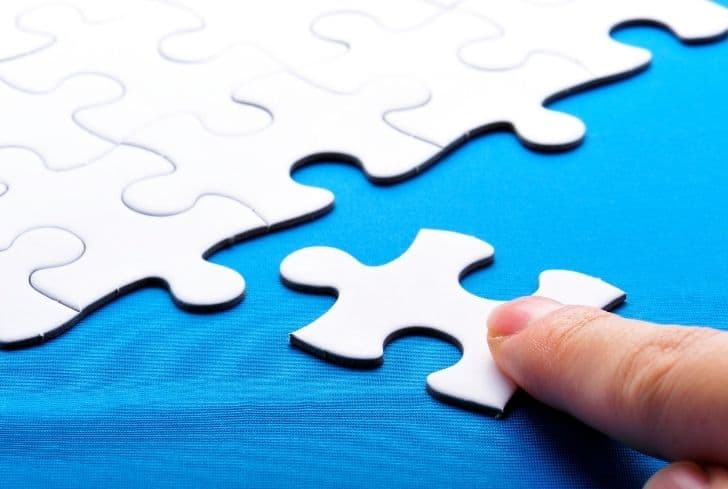Did you know that jigsaw puzzles are great for the brain? They improve your visual-spatial and cognitive reasoning, help with your concentration, and can be great for resolving problems associated with short-term memory.
But of course, the most common reason people love these puzzles is that they keep us entertained and occupied. If you have kids, you can use jigsaw puzzles as an educative distraction, with a prize attached, of course!
However, what are the puzzles made of? Typically, they’re small pieces that we need to attach to form a picture, which means when we have to dispose of them, we need to be cautious. So, are jigsaw pieces recyclable?
If you’re curious about how to dispose of jigsaw puzzles properly, please, read on. We’re certain that this blog post also contains information about some things you didn’t know you needed answers to. Dive in!
Are Jigsaw Puzzles Recyclable?
Jigsaw puzzles are an engaging way to pass the time. They come in an array of colors, designs and concepts, making them a pretty engaging activity for any audience.
For instance, if you love cars, you can get a jigsaw puzzle about cars. Upon completing the arrangement, you may get a BMW, Benz, or any car you’ve particularly chosen.
So, you see, jigsaw puzzles are pretty popular. This means that there’ll be tons of puzzles to dispose of yearly, which makes it important that there are proper ways to go about it.
One of the most environmentally friendly ways to dispose of anything is to recycle it. That way, we’ll be reducing our consumption of new materials, fuel, and packaging materials. It also ensures that the materials we recycle don’t end up sitting on our landfills for hundreds of years, as most of them are prone to do.
Now, this begs the important question – are jigsaw puzzles recyclable? Of course, after completing your puzzle piece, you can’t keep it as a trophy forever. You’ll have to dispose of it.
Is recycling one of your options? Well, it’s a bit tricky. For one, it’s difficult to recycle small materials like puzzle pieces because there isn’t always enough time to sort through the pieces. Imagine sorting through a 1,000- or 500-piece puzzle at the recycling center!
However, it can be done. But again, you’ll have to make the work easy for the workers at the recycling plant by ensuring that you place all the pieces in a bag or the box it comes in.
Next, reach out to the workers at the recycling center in your area to find out if they accept jigsaw puzzles. While we can recycle paper, you may have difficulty finding a recycling center that’ll accept small pieces like your jigsaw puzzle pieces.
So, instead, you may want to consider other ways to dispose of them. But, of course, you can trust us to help out with that, as you’ll come to realize subsequently.
How Are Jigsaw Puzzles Made?
Sure, you’re fascinated by jigsaw puzzles – you have them at every corner of your home. But have you ever stopped to wonder how they’re made? Well, we’ve got you covered if you have!
Let’s start with what they’re made from.
But first, some history. Jigsaw puzzles were first introduced in the 1760s by John Spilsbury, a European calligrapher. It started with maps, and after John’s death, the reach of jigsaw puzzles extended beyond maps.
The puzzles were made from a range of things and were printed on paper. But, of course, back then, they had just monochrome colors – black and white. So, when color printing was introduced in the 1800s, puzzles became even more popular.
By now, we’re certain you already have an idea that paper has always been a key component in making jigsaw puzzles.
So, let’s talk about how manufacturers make them. First, the artwork that would serve as the basis for the puzzle is needed. These days, the artworks are virtual, which means manufacturers can mass produce them.
Next, we need backing material. Cardboard is the most common option because it’s easy to work with. But again, wood is also an excellent option, and it’s more popular in the more expensive market.
Cutting equipment is also important, and the manufacturer also has to settle on the design type.
Now, here’s how jigsaw puzzles are made.
Printing is the first step – the manufacturer places the desired artwork over a special plate designed to absorb water or oil. Then, a series of scientific actions occur, resulting in the puzzle base absorbing the desired design.
Next is the die cutting stage. Here, the die cutting press cuts out each unique piece of the puzzle. We’re certain you know that each puzzle has to fit perfectly with the next, which makes puzzle-making time-consuming. This stage alone can consume as much as 400 hours.
The final stage is packaging, and it’s here that all the pieces of the puzzle will go into the packaging box. If you’ve bought a puzzle before, then you that the image you’re supposed to arrange will be printed on the cover of the box.
After completing the packaging stage, the boxes will be shipped to retail stores for sale.
Making jigsaw puzzles takes a lot of time. In fact, studies have shown that about 2,000 hours go into making these fascinating puzzles, and that time typically spans over the space of a year.
Can Puzzles Help With Anxiety?
Anxiety is one of the mental conditions that 284 million people have to deal with yearly. As a mental condition, it goes beyond feeling slightly queasy before giving a speech or before an important interview.
Instead, it’s an almost constant feeling which can hamper a lot of activities you enjoy. So, it’s only normal to seek ways to get rid of it, or at least bring it under reins.
Now, this is why physiologists recommend jigsaw puzzles sometimes. First, of course, it helps with anxiety. Second, constantly attempting these puzzles changes how your brain functions.
Since the major cause of anxiety is worrying and letting your mind run free, a controlled activity like arranging jigsaw puzzles can help you control it better.
In addition, it provides a healthy distraction, thereby reducing your flight or fight response. It’s a healthy way to remove yourself from activities or people that trigger your anxiety episodes.
It also helps you meditate. Focusing on a task as simple as completing a jigsaw puzzle can help you meditate. Again, your mind will focus entirely on the task at hand, thereby freeing you from anxious thoughts.
Finally, when you complete your puzzle, you’ll certainly feel great about yourself. Sometimes, our anxiety comes from feeling inadequate, like we can’t do anything right. So, when we complete that puzzle, the sense of achievement we feel is almost unrivaled, and it certainly goes a long way!
Are Jigsaw Puzzles Good For Your Brain?
Without a doubt! Beyond having fun with a jigsaw puzzle, did you know that it’s also great for your brain? Here are four awesome ways attempting and completing these puzzles help your brain:
1. They exercise your brain
If you want to exercise your brain’s left and right sides, then what you need is a jigsaw puzzle. The left part of your brain is responsible for logical thinking, while the right side of your brain helps with creativity and intuition.
Now, when you’re arranging a jigsaw puzzle, both sides are working actively together, thereby helping you exercise your brain.
2. They improve visual-spatial reasoning
This skill is super handy for driving, using maps, learning how to dance, among many others. You can sharpen it by attempting jigsaw puzzles regularly, and that’s because you need to visualize and arrange the pieces in their normal order.
3. Jigsaw puzzles help with short-term memory
Jigsaw puzzles help you improve your mental speed by reinforcing brain cell connections. Attempting these puzzles will keep your mind and brain sharp and will deal with short-term memory problems for you.
4. They stimulate the brain
Did you know that people who enjoy jigsaw puzzles are less likely to suffer from Alzheimer’s when they grow older? That’s because they have sufficiently stimulated their brain when they were younger, thereby preventing a receding memory.
Studies have also shown that people who attempted jigsaw puzzles when they were younger had brain scans in a ballpark with current youngsters.
So, attempt a jigsaw puzzle today!
What to do With Old Jigsaw Puzzles?
Since you’ve come this far, you must know that recycling jigsaw puzzles isn’t easy or even possible most of the time. Now, as environmentally conscious individuals, it’s still our responsibility to dispose of our waste properly, even when recycling isn’t an option.
As such, there are several other ways to dispose of a jigsaw puzzle. Here are a few of them:
1. Wall Art
Have you newly completed your first or even fifth jigsaw puzzle? Well, a great way to dispose of it is to turn it into wall art. Now, jigsaw puzzles come in all shapes, colors and designs.
If you fancy animals, you’re likely choosing a puzzle with a dog or cat design. When you complete it, it’s an excellent idea to use an adhesive to hold the puzzles in place, frame them, and hang them in your home. It’ll represent both a trophy and a beautiful art addition.
2. Bookmarks
This hack is awesome if you fancy a good book from time to time. But of course, you can’t always read your favorite books, as you likely have other activities to attend to.
So, you’ll have to put it aside sometimes. Did you know that you can use your old jigsaw puzzle pieces to make creative bookmarks? You’ll need an adhesive for this hack, any material that’s suitable for holding your pages apart, and some jigsaw puzzle pieces.
Piece them together, and you’ll have your new set of bookmarks!
3. Wreaths
You can get creative once more by arranging your jigsaw pieces into a Christmas wreath. But first, you need to paint it the color of Christmas.
When you’re done painting, just as you completed the jigsaw puzzle, fashion the pieces into a wreath, and hang it at your doorstep next Christmas.
4. Christmas Tree Ornaments
Great news! You no longer have to run down to the store to get Christmas ornaments for your tree. Instead, you can get creative with your jigsaw puzzles. They come in all shapes and sizes, so you can attach them with safety pins to your tree.
Alternatively, you could also thread them and wrap them around your Christmas tree. There’s an array of ways you can use jigsaw puzzle pieces to decorate your tree – you just need to tap into your creative side.
Conclusion
Arranging jigsaw puzzles is a mentally challenging and fun way to pass the time, and that’s one of the things that make them so popular. However, their popularity results in questions such as how to dispose of them properly, and we’ve answered them in this blog post.






